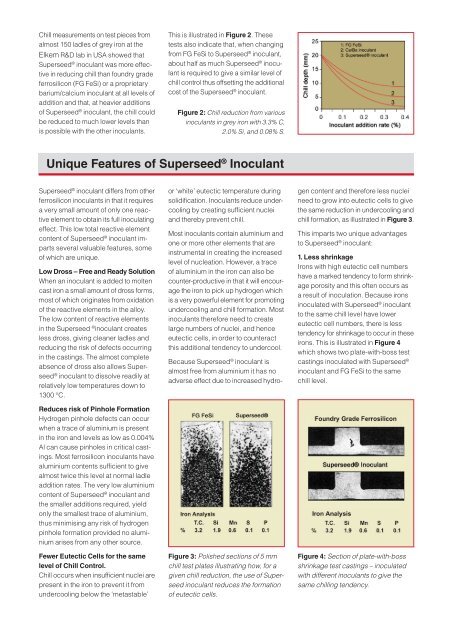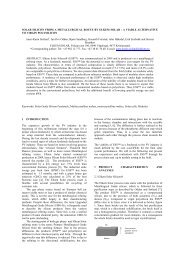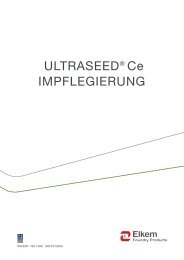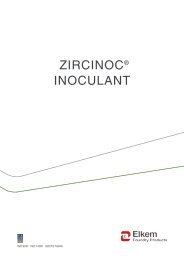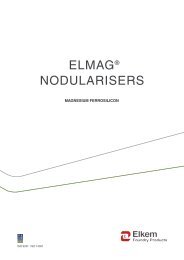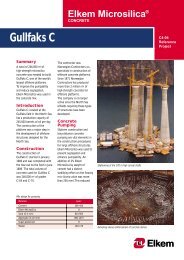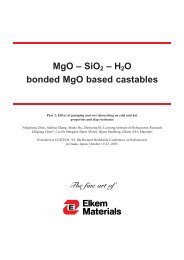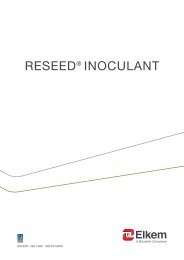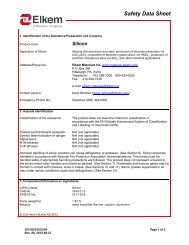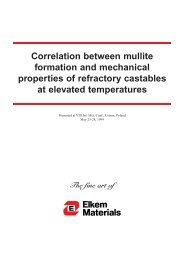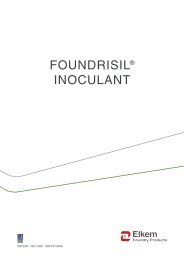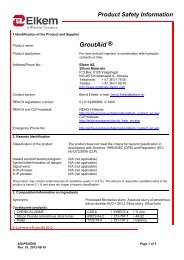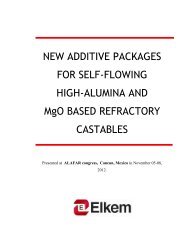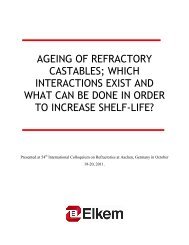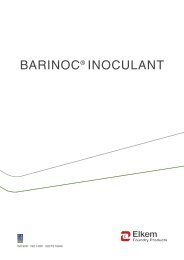SUPERSEED® INOCULANT - Elkem
SUPERSEED® INOCULANT - Elkem
SUPERSEED® INOCULANT - Elkem
You also want an ePaper? Increase the reach of your titles
YUMPU automatically turns print PDFs into web optimized ePapers that Google loves.
Chill measurements on test pieces from<br />
almost 150 ladles of grey iron at the<br />
<strong>Elkem</strong> R&D lab in USA showed that<br />
Superseed ® inoculant was more effective<br />
in reducing chill than foundry grade<br />
ferrosilicon (FG FeSi) or a proprietary<br />
barium/calcium inoculant at all levels of<br />
addition and that, at heavier additions<br />
of Superseed ® inoculant, the chill could<br />
be reduced to much lower levels than<br />
is possible with the other in oculants.<br />
This is illustra ted in Figure 2. These<br />
tests also indicate that, when changing<br />
from FG FeSi to Superseed ® inoculant,<br />
about half as much Superseed ® inoculant<br />
is required to give a similar level of<br />
chill control thus off setting the additional<br />
cost of the Superseed ® inoculant.<br />
Figure 2: Chill reduction from various<br />
inoculants in grey iron with 3.3% C,<br />
2.0% Si, and 0.08% S.<br />
Unique Features of Superseed ® Inoculant<br />
Superseed ® inoculant differs from other<br />
ferrosilicon inoculants in that it requires<br />
a very small amount of only one reactive<br />
element to obtain its full inoculating<br />
effect. This low total reactive element<br />
content of Superseed ® inoculant imparts<br />
several valuable features, some<br />
of which are unique.<br />
Low Dross – Free and Ready Solution<br />
When an inoculant is added to molten<br />
cast iron a small amount of dross forms,<br />
most of which originates from oxidation<br />
of the reactive elements in the alloy.<br />
The low content of reactive elements<br />
in the Superseed ® inoculant creates<br />
less dross, giving cleaner ladles and<br />
reducing the risk of defects occurring<br />
in the castings. The almost complete<br />
absence of dross also allows Superseed<br />
® inoculant to dissolve readily at<br />
relatively low temperatures down to<br />
1300 °C.<br />
Reduces risk of Pinhole Formation<br />
Hydrogen pinhole defects can occur<br />
when a trace of aluminium is present<br />
in the iron and levels as low as 0.004%<br />
Al can cause pinholes in critical castings.<br />
Most ferrosilicon inoculants have<br />
aluminium contents sufficient to give<br />
almost twice this level at normal ladle<br />
addition rates. The very low aluminium<br />
content of Superseed ® inoculant and<br />
the smaller additions required, yield<br />
only the smallest trace of aluminium,<br />
thus minimising any risk of hydrogen<br />
pinhole formation provided no aluminium<br />
arises from any other source.<br />
Fewer Eutectic Cells for the same<br />
level of Chill Control.<br />
Chill occurs when insufficient nuclei are<br />
present in the iron to prevent it from<br />
undercooling below the ‘metastable’<br />
or ‘white’ eutectic temperature during<br />
solidification. Inoculants reduce undercooling<br />
by creating sufficient nuclei<br />
and thereby prevent chill.<br />
Most inoculants contain aluminium and<br />
one or more other elements that are<br />
instrumental in creating the increased<br />
level of nucleation. However, a trace<br />
of aluminium in the iron can also be<br />
counter-productive in that it will encourage<br />
the iron to pick up hydrogen which<br />
is a very powerful element for promoting<br />
undercooling and chill formation. Most<br />
inoculants therefore need to create<br />
large numbers of nuclei, and hence<br />
eutectic cells, in order to counteract<br />
this additional tendency to undercool.<br />
Figure 3: Polished sections of 5 mm<br />
chill test plates illustrating how, for a<br />
given chill reduction, the use of Superseed<br />
ino culant reduces the formation<br />
of eutectic cells.<br />
Because Superseed ® inoculant is<br />
almost free from aluminium it has no<br />
adverse effect due to increased hydrogen<br />
content and therefore less nuclei<br />
need to grow into eutectic cells to give<br />
the same reduction in undercooling and<br />
chill formation, as illustrated in Figure 3.<br />
This imparts two unique advantages<br />
to Superseed ® inoculant:<br />
1. Less shrinkage<br />
Irons with high eutectic cell numbers<br />
have a marked tendency to form shrinkage<br />
porosity and this often occurs as<br />
a result of inoculation. Because irons<br />
inoculated with Superseed ® inoculant<br />
to the same chill level have lower<br />
eutectic cell numbers, there is less<br />
tendency for shrinkage to occur in these<br />
irons. This is illustrated in Figure 4<br />
which shows two plate-with-boss test<br />
castings inoculated with Superseed ®<br />
inoculant and FG FeSi to the same<br />
chill level.<br />
Figure 4: Section of plate-with-boss<br />
shrinkage test castings – inoculated<br />
with different inoculants to give the<br />
same chilling tendency.


